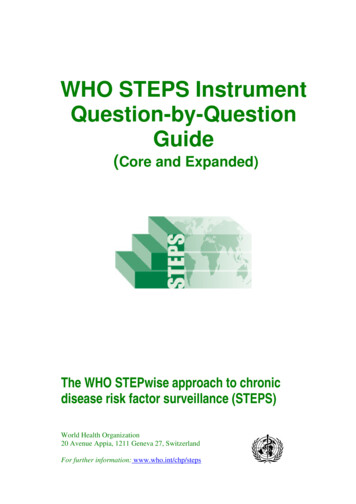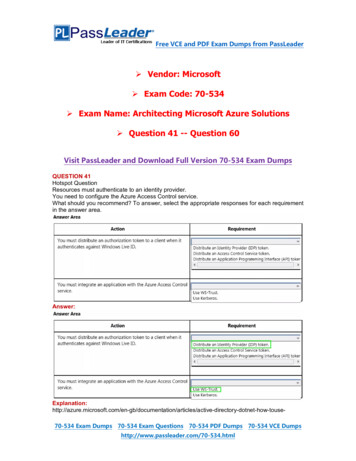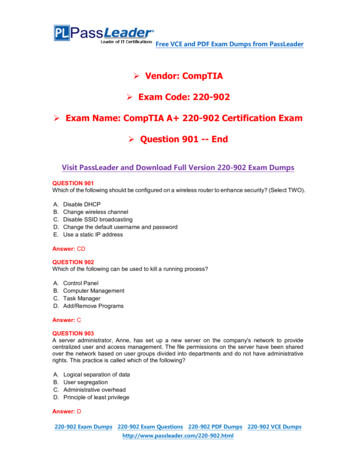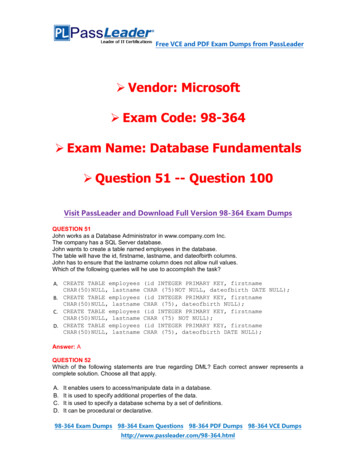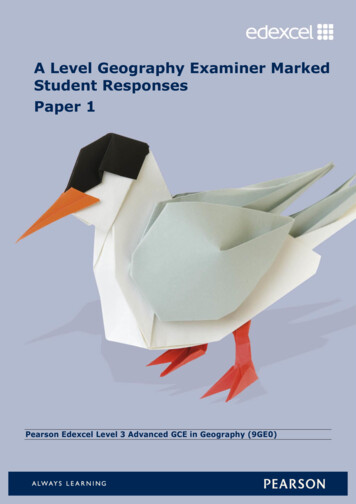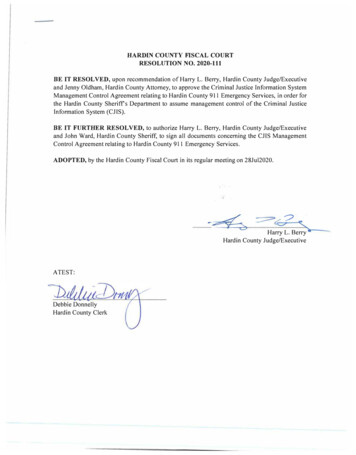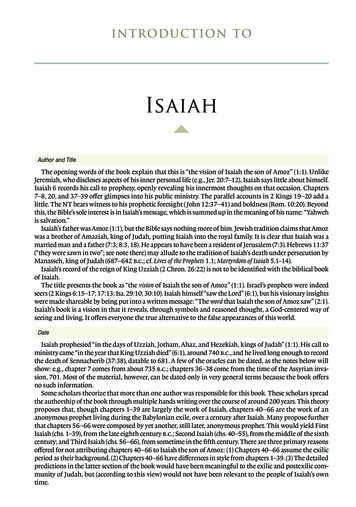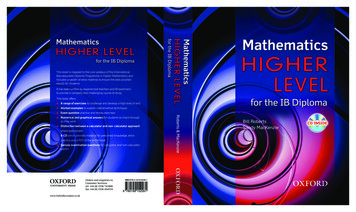
Transcription
This book is mapped to the core syllabus of the InternationalBaccalaureate Diploma Programme in Higher Mathematics andincludes a wealth of extra material to ensure the best possibleresults for students.It has been written by experienced teachers and IB examinersto provide a complete and challenging course of study.This book offers: A range of exercises to challenge and develop a high level of skill Worked examples to explain mathematical techniques Exam question practice and review exercises Numerical and graphical answers for students to check throughas they work Distinction between a calculator and non- calculator approachwhere appropriate A CD which provides material for presumed knowledge, extrapractice and a PDF of the entire book Sample examination questions for calculator and non-calculatorpapers3Orders and enquiries toCustomer Services:tel. 44 (0) 1536 741068fax 44 (0) 1536 454519www.OxfordSecondary.co.uk915226 ib cvr.indd 114/11/07 11:33:24
About the AuthorsBill Roberts is an experienced educator, having taught mathematics in a number ofinternational schools for the past twenty years. He also works for the InternationalBaccalaureate as an examiner and trainer. Bill is currently based at the University ofNewcastle in England.Sandy MacKenzie is an experienced teacher of mathematics in both the InternationalBaccalaureate and the Scottish systems and works for the International Baccalaureate asan examiner. Sandy is currently Assistant Rector at Morrison’s Academy in Scotland.i
DedicationsTo my father, George Roberts, who encouraged and nurtured my love and appreciationfor mathematics.To Nancy MacKenzie, and the Cairns sisters, Alexia and Rosemary, my three mothers,without whom none of this would have been possible.PrefaceThis book is intended primarily for use by students and teachers of Higher LevelMathematics in the International Baccalaureate Diploma Programme, but will also be ofuse to students on other courses.Detailed coverage is provided for the core part of this syllabus and provides excellentpreparation for the final examination. The book provides guidance on areas of thesyllabus that may be examined differently depending on whether a graphical calculatoris used or not.Points of theory are presented and explained concisely and are illustrated by workedexamples which identify the key skills and techniques. Where appropriate, informationand methods are highlighted and margin notes provide further tips and importantreminders. These are supported by varied and graded exercises, which consolidate thetheory, thus enabling the reader to practise basic skills and challenging exam-stylequestions. Each chapter concludes with a review exercise that covers all of the skillswithin the chapter, with a clear distinction between questions where a calculator isMallowed and ones where it is not. The iconC7410M–M CE%89–56 23 ONX is used to indicate where a calculator M–MM ONmay be used, andindicates where it may not. Many of these questions are frompast IB papers and we would like to thank the International Baccalaureate for permissionto reproduce these questions.C7410CE%89–56 23 X Throughout the text, we have aimed to produce chapters that have been sequenced ina logical teaching order with major topics grouped together. However, we have alsobuilt in flexibility and in some cases the order in which chapters are used can bechanged. For example we have split differential and integral calculus, but these can betaught as one section. Although many students will use this book in a teacher-ledenvironment, it has also been designed to be accessible to students for self-study.The book is accompanied by a CD. As well as containing an electronic version of theentire book, there is a presumed knowledge chapter covering basic skills, revisionexercises of the whole syllabus grouped into six sections, and twenty extendedexam-style questions.We would like extend our thanks to family, friends, colleagues and students whosupported and encouraged us throughout the process of writing this book andespecially to those closest to each of us, for their patience and understanding.Bill RobertsSandy MacKenzie2007iiiii
ContentsContents1Trigonometry 11.11.21.31.41.51.61.7Circle problemsTrigonometric ratiosSolving trianglesTrigonometric functions and graphsRelated anglesTrigonometric equationsInverse trigonometric functions2Quadratic Equations, Functions and Inequalities2.12.22.32.42.5Introduction to quadratic functionsSolving quadratic equationsQuadratic functionsLinear and quadratic inequalitiesNature of roots of quadratic omposite functionsInverse functionsGraphs of inverse functionsSpecial functionsDrawing a graphTransformations of al functionsFactor and remainder theoremsFinding a polynomial’s coefficientsSolving polynomial equationsFinding a function from its graphAlgebraic long divisionUsing a calculator with polynomials5Exponential and Logarithmic Functions5.15.25.35.45.55.6Exponential functionsLogarithmic graphsRules of logarithmsLogarithms on a calculatorExponential equationsRelated graphs6Sequences, Series and Binomial Theorem6.16.26.36.46.56.66.76.8Arithmetic sequencesSum of the first n terms of an arithmetic sequenceGeometric sequences and seriesSum of an infinite seriesApplications of sequences and seriesSigma notationFactorial notationBinomial rigonometry 27.17.27.37.47.5IdentitiesCompound angle (addition) formulaeDouble angle formulaeUsing double angle formulaeWave function8Differential Calculus 1– Introduction8.18.28.38.48.58.68.7Differentiation by first principlesDifferentiation using a ruleGradient of a tangentStationary pointsPoints of inflexionCurve sketchingSketching the graph of the derived function9Differentiation 2 – Further ng trigonometric functionsDifferentiating functions of functions (chain rule)Differentiating exponential and logarithmic functionsProduct ruleQuotient ruleImplicit differentiationDifferentiating inverse trigonometric functionsSummary of standard resultsFurther differentiation problems10Differentiation 3 – Applications10.110.210.3Optimization problemsRates of change of connected variablesDisplacement, velocity and acceleration11Matrices11.111.211.311.4Introduction to matricesDeterminants and inverses of matricesSolving simultaneous equations in two unknownsSolving simultaneous equations in three unknowns12Vector Techniques12.112.212.3Introduction to vectorsA geometric approach to vectorsMultiplication of vectors13Vectors, Lines and Planes13.113.213.313.4Equation of a straight lineParallel, intersecting and skew linesEquation of a planeIntersecting lines and planes14Integration 114.114.214.314.414.514.614.714.814.9Undoing differentiationConstant of integrationInitial conditionsBasic resultsAnti-chain ruleDefinite integrationGeometric significance of integrationAreas above and below the x-axisArea between two 2385391395v
Contents15 Integration 2 – Further 0Integration as a process of anti-differentiation – direct reverseIntegration of functions to give inverse trigonometric functionsIntegration of powers of trigonometric functionsSelecting the correct technique 1Integration by substitutionIntegration by partsMiscellaneous techniquesFurther integration practiceSelecting the correct technique 2Finding the area under a curve16 Integration 3 – Applications16.116.216.316.416.516.6Differential equationsSolving differential equations by direct integrationSolving differential equations by separating variablesVerifying that a particular solution fits a differential equationDisplacement, velocity and accelerationVolumes of solids of revolution17 Complex Numbers17.117.217.317.4Imaginary numbersComplex numbersArgand diagramsde Moivre’s theorem18Mathematical Induction18.118.218.3Introduction to mathematical inductionProving some well-known resultsForming and proving conjectures19Statistics19.119.219.319.4Frequency tablesFrequency diagramsMeasures of dispersionUsing a calculator to perform statistical ntroduction to probabilityConditional probabilityIndependent eventsBayes’ theoremPermutations and combinationsProbability involving permutations and combinations21Discrete Probability Distributions21.121.221.321.4Introduction to discrete random variablesExpectation and varianceBinomial distributionPoisson distribution22 Continuous Probability Distributions22.122.222.322.422.5Continuous random variablesUsing continuous probability density functionsNormal distributionsProblems involving finding µ and sApplications of normal 9633–672634639652660662673721
1 Trigonometry 1Although most peopleconnect trigonometrywith the study oftriangles, it is from thecircle that this area ofmathematics originates.The study of trigonometry is not new. Its roots come from the Babylonians around300 BC. This area of mathematics was further developed by the Ancient Greeks around100 BC. Hipparchus, Ptolemy and Menelaus are considered to have foundedtrigonometry as we now know it. It was originally used to aid the study of astronomy.In the modern world trigonometry can be used to answer questions like “How farapart are each of the 32 pods on the London Eye?” and “What would a graph ofsomeone’s height on the London Eye look like?”1.1 Circle problemsRadiansIt is likely that up until now you have measured angles in degrees, but as for mostmeasurements, there is more than one unit that can be used.Consider a circle with radius 1 unit.1
1 Trigonometry 11 Trigonometry 1As u increases, the arc length increases. For a particularvalue of u, the arc will be the same length as the radius.When this occurs, the angle is defined to be 1 radian.Considering the infinite rotational symmetry of the circle,1The circumference of a circle is given by C 2pr, sowhen r 1, C 2p. arc lengthx sector area 360 2prpr21arcThat is, dividing the angle by 360 , the arc length by the circumference, and the sectorarea by the circle area gives the same fraction.As there are 360 at the centre of a circle, and 1 radian is defined to be the anglesubtended by an arc of length 1,This is very useful when solving problems related to circles.2p radians 360 Hence 1 radian Changing the angles to radians gives formulae for the length of an arc and the area of asector:360 57.3 .2parc lengthu 2p2prMethod for converting between degrees and radiansTo convert degrees to radians, multiply byTo convert radians to degrees, multiply by1 arc length rup2p .360 180 usector area 2ppr2180 360 .p2p1 sector area These formulae onlywork if u is in radians.1 2ru2 Some angles measured in radians can be written as simple fractions of p.You must learn these.Degrees0 15 30 45 60 90 180 270 360 Radians0p12p6p4p3p2p3p22pExampleWhere an angle is givenwithout units, assume itis in radians.What is the area of the sector shown below?1 2ru21p 82 23Sector area Example 38 cm 33.5 cm22pradians into degrees.3p2p 60 1see table 2 so 60 2 120 .33ConvertExampleExampleThe fairground ride shown below moves through an angle of 50 from pointA to point B. What is the length of the arc AB?Convert 250 into radians.This is not one of the commonly used angles (nor a multiple), so use the methodfor converting degrees to radians.250 25pp 4.36180 18ACircle sectors and segmentsSegmentArcchordSector250 x 16 mB50 2p360 0.872 pHence arc length ru 16 0.872 p 13.96 mStart by converting 50 into radians. u arc3
1 Trigonometry 11 Trigonometry 13 Express each angle in radians, giving your answer to 3 sf.Examplea 35 b 100 c 300 d 80 e 132 f 278 4 Find the area of each shaded sector.abWhat is the volume of water lying in this pipe of radius 2.5 m? 3 3m55 8 cm4m15 mcIn this example, we need to find the area of a segment. The method for doingthis is:Area of segment Area of sector Area of triangled50 Fan140 20 cmIt is important toremember this.60 cm5 Find the length of each arc.ab7 187m30 12cmFirst find the angle at the centre in radians:12u sin 122.5 0.927 pcd65 cm7.5 1 2260 25 mm100 21Area of triangle 4 1.52 3 m211Area of sector r2u 2.52 0.972 p 222 5.79 p m2Use Pythagoras to findthe height of thetriangle.6 Find the perimeter of each shape.abc16 mm125 26 cm60 mm Area of segment Area of sector Area of triangle 5.79 p 3 2.79 p m2Volume 2.79 p 15 41.9 m3Exercise 11 Express each angle in degrees.3pp2p5p7ppbcdef495612811pgh 2i 1.5j 4k 3.6l 0.4182 Express each angle in radians, giving your answer in terms of p.a 30 b 210 c 135 d 315 e 240 f 70 g 72 h 54 a470 cm7 The diagram below shows a windscreen wiper cleaning a car windscreen.a What is the length of the arc swept out?b What area of the windscreen is not cleared?8 955 cm45 cm100 cm8 Find the area of the shaded segment.60 24 cm5
1 Trigonometry 11 Trigonometry 19 What is the area of this shape?1.2 Trigonometric ratiosThis unit circle can be used to define the trigonometric ratios.y1Diameter 8 m5mP(x,y)10 Radius 32 cm 10Area of sector 1787 cmWhat is the angle at the centre of the sector?1x2 1You should already know that for a right-angled triangle11 Find the perimeter of this segment. 46 cmHyp12 A sector has an area of 942.5 cm2 and an arc length of 62.8 cm. What issin u OppositeHypotenusecos u AdjacentHypotenusetan u OppositeAdjacentOpp Adjthe radius of the circle?rThe x-coordinate is defined to be cos u.The y-coordinate is defined to be sin u.13 Two circles are used to form the logo for a company as shown below. Onecircle is of radius 12 cm. The other is of radius 9 cm. Their centres are 15 cmapart. What is the perimeter of the logo?The results for a right-angled triangle follow from the definitions of the x- and ycoordinates in the unit circle.tan u yOpp1 tan u xAdjHyp114 What is the ratio of the areas of the major sector in diagram A to the minorsector in diagram B?A OppyxAdjB1 tan u r150 sin ucos ur 60 This is the definition of tan u and is a useful identity.15 Two circular table mats, each of radius 12 cm, are laid on a table with theircentres 16 cm apart. Finda the length of the common chordb the area common to the two mats.More work will bedone on trigonometricidentities in Chapter 7.Using the definition of sin u and cos u from the unit circle, we can see that thesetrigonometric ratios are defined not only for acute angles, but for any angle. For example,sin 120 0.866 (3 sf).As the x-coordinate is cos u and the y-coordinate is sin u, for obtuse angles sin u ispositive and cos u is negative.y Exact values0xYou need to learn sin, cos and tan of the angles given in the table overleaf for non-calculatorexaminations.67
1 Trigonometry 11 Trigonometry 1U (in radians)0p6p4p3p2ExampleU (in degrees)0 30 45 60 90 Solve cos u sin U0121cos U1232tan U122120123undefined2211023223cos u The last row is givensin uby tan u .cos u1for 0 u 6 2p.212y11 u cos 1 2pp1 u or u 2p 33p5p1 u or u 33012xThese values can also be remembered using the triangles shown below.Exercise 245 30 221 31 Find the value of each of these.a sin 150 b sin 170 c cos 135 d cos 175 2p3p5pe sinf sing cosh cos 2.4(radians)3462 Without using a calculator, find the value of each of these.ppp2pa sinb cosc tand sin63435pe cosf sin 135 g cos 315 h sin 180 3i cos 180 j cos 270 60 145 1Finding an angleWhen solving right-angled triangles, you found an acute angle.3 Find the possible values of x , given that 0 x 6 360 .112a sin x b cos x c sin x 233413d cos x e sin x f cos x 687Examplesin u 52521 u sin 1 51 u 23.6 2 4 Find the possible values of u, given that 0 u 6 2p.ysin u 250x12b sin u 232c cos u d sin u 2e cos u 232f sin u a cos u 2However, sin u has two possible solutions:5251 u 23.6 or 154.6 This is recognizing thesymmetry of the circle.g cos u 41112227h sin u 0.71.3 Solving trianglesAcB8baCVertices are given capitalletters. The side oppositea vertex is labelled withthe correspondinglower-case letter.9
1 Trigonometry 11 Trigonometry 1Area of a trianglePutting these results together gives the sine rule:abc sin Asin Bsin CWe know that the area of a triangle is given by the formula1A base perpendicular height2Look at this obtuse-angled triangle:hAbaseTo be able to use this formula, it is necessary to know the perpendicular height. Thisheight can be found using trigonometry.ABsin C bhBCIf we consider the unit circle, it is clear that sin u sin1180 u2 and hencesin u sin B. So the result is the same.hbUse the sine rule in this form when finding a side:1 h b sin CCa This is dealt with inmore detail later in thechapter in relation totrigonometric graphs.abc sin Asin Bsin CSo the area of the triangle is given byUse the sine rule in this form when finding an angle:1Area ab sin C2This formula is equivalent tosin Asin Bsin C abc1 one side another side sine of angle between.2ExampleExampleFind x.BFind the area of this triangle.Area 6 cm1 6 7 sin 40 2Ax8m60 40 ba sin Asin Bx81 sin 40 sin 60 8 sin 40 1x sin 60 1 x 5.94 mC 13.5 cm40 27 cmSine ruleNot all triangle problems can be solved using right-angled trigonometry. A formulacalled the sine rule is used in these problems.AhcBDbCaADsin B ABADsin C AC1 AD AB sin B1 AD AC sin C1 AD c sin BFind angle P.Q81 AD b sin C1 c sin B b sin C1100 Pbc sin Bsin CDrawing a line perpendicular to AC from B provides a similar result:10Exampleca sin Asin C12Rsin Psin Q pqsin Psin 100 1 8128 sin 100 1 sin P 121 sin P 0.656 p1 P 41.0 11
1 Trigonometry 11 Trigonometry 1When the given angle is acute and it is opposite the shorter of two given sides, there aretwo possible triangles.Nowx cos uc cos1180 B2We will return to thislater in the chapter. cos BExample1 x c cos BIn a triangle, angle A 40 , a 9 and b 13. Find angle B.sin Bsin 40 913A13 sin 40 1 sin B 91 sin B 0.928 p1 B 68.1 or B 180 68.1 111.9 a1 b2 a2bB68.1 9111.9 40 Ac2 2ac cos BExampleFind x.9x 811 2 8 11 cos 35 x 40.829 px 6.39 m240 A2ac cos BThis situation is similar to the area of the triangle formula. The different forms do notneed to be remembered: it is best thought of as two sides and the angle in between.Hence it is possible to draw two different triangles with this information:B1 c2 b2 a2C138mx35 11 mCosine ruleThe sine rule is useful for solving triangle problems but it cannot be used in everysituation. If you know two sides and the angle between them, and want to find the thirdside, the cosine rule is useful.Pythagoras’ theorem canbe considered a specialcase of the cosine rule.This is the case whereA 90 1 cos A 0.The cosine rule can be rearranged to find an angle:a2 b2c2 2bc cos A1 2bc cos A b2c2 a2The cosine rule isa2 b222C1321 cos A c2 2bc cos Ab2This is only one form.It may be useful tore-label the vertices inthe triangle.c2 a22bcWe can prove this using an acute-angled triangle:We know that h2 c2 1a x2 2 c2 a22ax x2 and h2 b2 x2.HenceAb x c a2221c a2cBha x DabExample2ax x2b 2ax2Find angle A.cos A xb1 x b cos CNow cos C Cx221 c2 a21712c2 2bc cos Ab2 a2c2 2ac cos BAb2 2ab cos C172 142 1222 17 14 0.716 p1 A 44.2 14ExampleThe proof for an obtuse-angled triangle is similar:In triangle ABD,In triangle ACD,AhcD xBh b 1ah c xb2a2222x2N1 c x b a 2ax x2221 c b a 2ax222A ship sails on a bearing of 065 for 8 km,then changes direction at Q to a bearing of120 for 13 km. Find the distance andbearing of R from P.N28 km b2 a2 2ax x2C212c2 a22bc1 cos A Drawing the perpendicular from the other vertices provides different versions of the rule:a2 b2b2265 120 Q13 kmPxR13
1 Trigonometry 11 Trigonometry 1cN17 cmTo find the distance x, angle Q is needed.NQ65 65 Pd120 π36m125 10 m23 cm60 2 Three roads intersect as shown, with a triangular building plot betweenthem. Calculate the area of the building plot.As the north lines are parallel, we can findangle Q.So Q 125 1 x 18.8 km70mPLOT110 250132 2 8 13 cos 125 x2 352.3 pmUsing the cosine rule, x2 82NWe can now find the bearing of R from P.65 Using the sine rule,sin Psin 125 1318.8PR3 A design is created by an equilateral triangle of side 14 cm at the centre of a circle.a Find the area of the triangle.b Hence find the area of the segments.13 sin 125 0.566 p18.81 P 34.5 1 sin P Bearing of R from P is 6534.5 099.5 .4 An extension to a house is built as shown.What is the volume of the extension?Decision making about triangle problems2m3m65 It is worth remembering that Pythagoras’ theorem and right-angled trigonometry can beapplied to right-angled triangles, and they should not need the use of the sine rule orthe cosine rule.5.5 m3.5 mFor non-right angled triangles, use this decision tree.5 Find the area of this campsite.sideangle100 7m37 m20 29 m6 Use the sine rule to find the marked side.know two sides andthe angle betweenotherwisecosine rulea2 b2c2 2bc cos Aotherwisesine rulecab sin A sin B sin Csine rulesin A sin B sin C bcaknow all three sidescosine rulecos A b2c2 a22bcOnce two angles in atriangle are known, thethird angle can be foundby subtracting the othertwo angles from 180 .abB75 AcC7cmdUeb7m80 A6 cm18 mm52 37 6mTRRxS20 P125 1 Calculate the area of each triangle.30 xx55 Exercise 38 cm18 cm80 40 aQN9 cmnπ4π3MCx12 cmB1415
1 Trigonometry 11 Trigonometry 17 Use the sine rule to find the marked angle.abBAx1930 C7 cmQ128 Triangle LMN has sides LM 32 m and MN 35 m with LNM 40 Find the possible values for MLN.9 Triangle ABC has sides AB 11 km and BC 6 km and BAC 20 .Calculate BCA.10 Use the cosine rule to find the marked side.bU6 cm55 TS16 A plane flies from New York JFK airport on a bearing of 205 for 200 km.Another plane also leaves from JFK and flies for 170 km on a bearing of320 . What distance are the two planes now apart?Nx170 kmVJFK200 km22 m70 RB210 mmC17 Twins Anna and Tanya, who are both 1.75 m tall, both look at the top ofCleopatra’s Needle in Central Park, New York. If they are standing 7 m apart,how tall is the Needle?d68 9.6 cm140 p195 mmT19 cmL29 cm17 mxc45 JT7 cmx100 55 URK80 x 50 aeSP10 cmx dAt11 A golfer is standing 15 m from the hole. She putts 7 off-line and the balltravels 13 m. How far is her ball from the hole?13 m50 40 7 15 m18 Find the size of angle ACE.12 Use the cosine rule to find the marked angle.QabBAC38 cm17 cm1.7 m2.5 mPBAC23 cm8mH13 Calculate the size of the largest angle in triangle TUV.UE9m19 Find the area of triangle SWV.91 mmTFGR2.2 m6mDR88 mmV101 mmSPQ8 cm14 Find the size of all the angles in triangle ABC.UTB15 cm1.1 mA0.7 mC0.8 m15 Calculate x in each triangle.abY16cDxZV29 cmsin u is defined as the y-coordinate of points on the unit circle.P88 km131 km8.2 mE24 cm1.4 Trigonometric functions and graphsx 62 6.3 mWW60 26 cmFQx 107 kmU0 30 sin U012R45 60 90 180 270 360 123210 102217
1 Trigonometry 11 Trigonometry 1y cos uy1y1 1010 2 1x2 4 6 1cos u is defined as the x-coordinate of points on the unit circle.Ucos U0 30 45 60 123211290 180 270 Repeating at regular intervals is known as periodicity. The period is the intervalbetween repetitions.360 For y sin u and y cos u, the period is 360 or 2p.22 1001Graph of tan x These functions are plotted below.We have defined tan u asysin u. This allows us to draw its graph.cos uy cosx 1U0 30 45 60 90 180 270 360 sin U012123210 10cos U123222120 101tan U01230undefined0x 090 180 270 360 Both graphs only havey-values of 1 y 1.y sinx 1PeriodicityWhen considering angles in the circle, it is clear that any angle has an equivalent anglein the domain 0 x 6 360 .For example, an angle of 440 is equivalent to an angle of 80 .x 440 360 231undefinedThere is a problem when x 90 , 270 p because there is a zero on the denominator.This is undefined (or infinity). Graphically, this creates a vertical asymptote. This iscreated by an x-value where the function is not defined. The definition of an asymptoteis that it is a line associated with a curve such that as a point moves along a branch ofthe curve, the distance between the line and the curve approaches zero. By examiningeither side of the vertical asymptote, we can obtain the behaviour of the functionaround the asymptote.y012280 The vertical asymptote isa line: there are othertypes of asymptote thatwe will meet later.As x S 90 (x approaches 90 ) tan x increases and approaches q (infinity):This is also true for negative angles.tan 85 11.4, tan 89 57.3, tan 89.9 573 etc.yOn the other side of the asymptote, tan x decreases and approaches q:240 0 120 tan 95 11.4, tan 91 57.3, tan 90.1 573 etc.x The graph of y tan x is shown below. 120 240 yThis means that the sine and cosine graphs are infinite but repeat every 360 or 2p.y sin uyx 0 90 180 270 360 1 2 18 102 4 These graphs can bedrawn using degrees orradians.It is clear that this graph is also periodic, and the period is 180 .19
1 Trigonometry 11 Trigonometry 1Reciprocal trigonometric functionsComposite graphsThere are three more trigonometrical functions, defined as the reciprocal trigonometricfunctions – secant, cosecant and cotangent. Secant is the reciprocal function to cosine,cosecant is the reciprocal function to sine, and cotangent is the reciprocal function totangent. These are abbreviated as follows:Using your graphing calculator, draw the following graphs to observe the effects of thetransformations.sec u 1,cos ucsc u 1. y 2 sin x y 3 cos x y 5 sin x 1y sin x 2111or cosec u2 cot u sin utan uIn order to obtain the graph of f 1x2 csc u, consider the table below.2. y sin 2x y cos 3x y sin 5x 1y cos x 2 U0 30 45 60 90 180 270 360 sin U01212223210 10q2221q 1qcsc U 1sin U2233. y sin x y cos x y tan x 4. y sin1 x 2y cos1 x 2y tan1 x 2The roots (zeros) of the original function become vertical asymptotes in the reciprocalfunction.y15. y sin x 2y cos x 2y sin x 1y cos x 1y csc u180 360 16. y sin1x 302 y cos1x 302 This function is also periodic with a period of 360 .Similarly we can obtain the graphs of y sec u and y cot u:yp 3y cos up 3The table summarizes the effects.y sec u1 90 y sin u90 1270 y EffectA sin x, A cos x,A tan xVertical stretchsin Bx, cos Bx,tan BxHorizontal stretch/compression sin x, cos x, tan xReflection in x-axissin1 x2, cos1 x2, tan1 x2Reflection in y-axisyy cot u 180 20 90 090 270 The general method forplotting reciprocalgraphs will be addressedin Chapter 8.sin xC, cos xsin1xD 2, cos1xC, tan xD2, tan1xCNotesThis is the onlytransformation thataffects the period ofthe graphVertical shiftD2Horizontal shiftPositive D left,negative D right21
1 Trigonometry 11 Trigonometry 1The domain tells youhow much of thegraph to draw andwhether to work indegrees or radians.ExampleDraw the graph of y 2 cos u1 for 0 u 6 2p.y30 12 This is a vertical stretch 2 and a verticalshift 1. Since it is “upside down” there is a reflection in the x axis 1 y cos uThere is a period of p and so there are two full waves in 2p 1 y cos 2uThere is a difference of 6 between the max and min values. There wouldnormally be a difference of 2 and hence there is a 3 vertical stretch1 y 3 cos 2uThe min and max values are 1, 7 so there is a shift up of 41 y 3 cos 2u 4So the equation of this graph is y 3 cos 2u4.Exercise 4ExampleDraw the graph of y csc1x 902 1 What is the period of each function?1 for 0 x 6 180 .adgjy20180 x This is a horizontal shift of 90 to the rightand a vertical shift 1.y sin 2x y tan 2x y 5 csc 2x 3y 8 tan 60x b y cos 3x e y sec x h y 7 3 sin 4uc y cos 4u 1f y 2 cos 3x 3i y 9 sin 10x 2 Draw the graphs of these functions for 0 x 6 360 .a y sin 3x b y cos x c y sin1 x 2d y 4 csc xe y tan1x 302 f y sec x 23 Draw the graphs of these functions for 0 u 6 2p.p 3e y 3 5 sin ua y sin 2ud y csc1 u2Examplec y 4 cos u 2y4 Draw the graphs of these functions for 0 x 6 180 .a y cos 3x b y 2 sin 4x c y 3 sec 2x d y 6 sin 10x e y 2 tan1x 302 f y 3 cos 2x 135 Draw the graphs of these functions for 0 u 6 p.Draw the graph of y 3 sin 2x for 0 x 6 360 .a y 6 cos u0 3x 90 180 270 360 In this case, there are two full waves in 360 .There is a reflection in the x-axis and a verticalstretch 3.What is the equation of this graph?We assume that, because of the shape, it is either asine or cosine graph. Since it begins at a minimumpoint, we will make the assumption that it is acosine graph. (We could use sine but this wouldinvolve a horizontal shift, making the question morecomplicated.) y cos ud y cot 3u2b y 3 sin 4u 5e y tan 2u c y 7 4 cos up 36 Draw the graph of y 4 sin 2x 3 for 0 x 6 720 .7 Draw the graph of y 6 cos 30x for 0 x 6 12 .p8 Draw the graph of y 8 3 sin 4u for 0 u 6 .29 Find the equation of each graph.abExample22b y cot u7yyy24102 0360 x 1O 423
1 Trigonometry 11 Trigonometry 1cdyy sin x y6360 0 2x y cos x yyy1110x 90 180 270 x 360 fy890 180 270 360 0 1ey tan x 090 180 270 360 x 1 1yThese graphs can be split into four quadrants, each of 90 . We can see that in the firstquadrant all three graphs are above the x-axis (positive).In each
practice and a PDF of the entire book Sample examination questions for calculator and non-calculator papers 3 Orders and enquiries to Customer Services: tel. 44 (0) 1536 741068 fax 44 (0) 1536 454519 www.OxfordSecondary.co.uk 9915226_ib_cvr.indd 115226_
